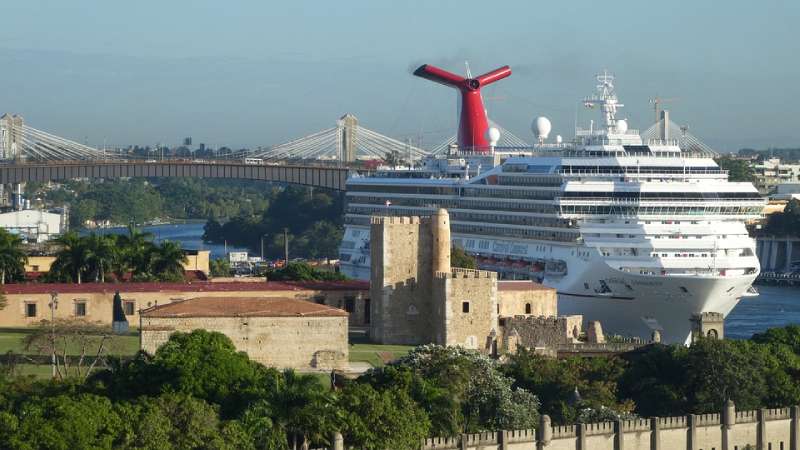Does your Caribbean cruise include a stopover in Santo Domingo? The capital of the Dominican Republic has a rich history, a vibrant culture, and stunning architecture. However, with so much to offer cruise ship passengers at this UNESCO World Heritage Site, choosing how to spend your day in port can be challenging.
Santo Domingo, in the Dominican Republic, is a popular cruise port stop in the Eastern Caribbean. If you are a history buff, Santo Domingo offers a rich cultural experience with many 16th-century buildings and museums in the famous Colonial Zone. Many of these buildings are close to the Don Diego Terminal.
If you are looking for fun activities or to see the lush Dominican Republic countryside, several shore excursions are available at both cruise ports in the city. Tours include spectacular waterfalls, swimming, and snorkeling. Alternatively, there are many beautiful beaches close to the city.
In this Santo Domingo cruise port guide, I’ve reviewed the top attractions and excursions to help you plan your time in port. From historical landmarks to local cuisine and shopping options, this guide will help you navigate Santo Domingo and make the most of your visit.
Whether you’re a first-time visitor or a seasoned traveler, you can plan an unforgettable experience in Santo Domingo.
Where is the Santo Domingo Cruise Port?
Santo Domingo is the largest city and the capital of the Dominican Republic. Two ports are situated on the east and west banks of the Ozama River. The Santo Domingo port is 150 miles (241 km) southeast of the Puerto Plata cruise port and 75 miles (120 km) west of La Romana, another popular cruise destination on the island.
Where Cruise Ships Dock in Santo Domingo
The Port of Santo Domingo has two piers where cruise ships dock: the Don Diego Terminal and the Sans Souci Cruise Terminal. Both ports also operate as homeport terminals, and travel time to the Las Américas International Airport is approximately 25 to 30 minutes.
Sans Souci Cruise Terminal
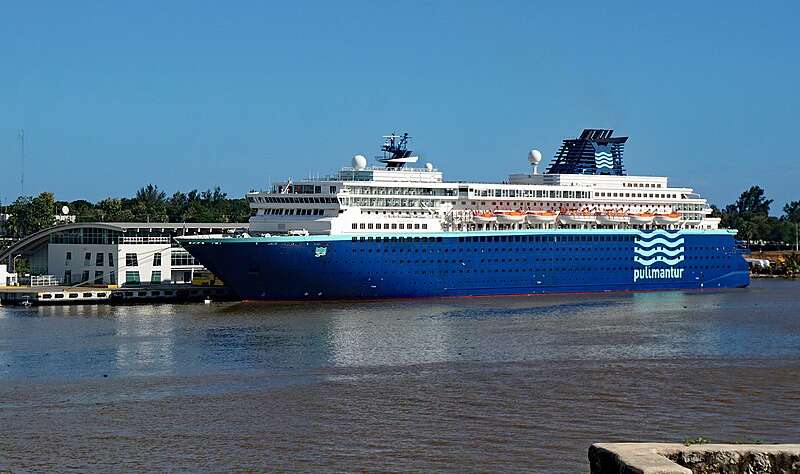
Located on the east bank of the River Ozama, the Sans Souci (also written Puerto Sansouci) terminal is a modern, state-of-the-art facility. After disembarking from the cruise ship, you will find duty-free stores, restrooms, and a viewing area. Licensed taxis and shore excursion buses are outside the terminal building if you’ve booked a tour.
Most cruise ships, especially larger ones, dock at the Sans Souci Pier.
Don Diego Quay
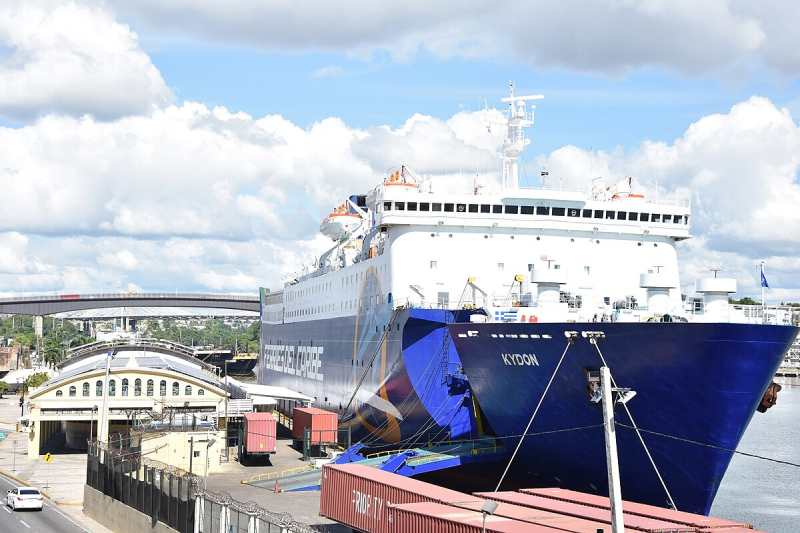
The Don Diego Quay in Santo Domingo Port is the closest to the Colonial City on the west side of the River Ozama. The spacious, well-lit terminal building has duty-free shops and an information center. This historic port is within walking distance of the city center and historical landmarks.
Facilities at the Santo Domingo Cruise Port
The two terminal buildings at the Santo Domingo Port have basic facilities for cruise passengers. Unlike many cruise ports in the Caribbean, there is no custom-built terminal area with swimming pools, bars, restaurants, and activities. This leaves passengers with two choices for a cruise day: staying on the ship or visiting Santo Domingo’s attractions.
Map of Santo Domingo
Arriving in Santo Domingo, Dominican Republic
When arriving in Santo Domingo on a cruise ship, you get excellent views of the oldest European city in the Americas. Depending on the cruise terminal where your ship docks, the city’s downtown area is a short walk or 10-minute taxi ride. The famous Colonial Zone, with its historical buildings and colonial architecture, is closest to the Don Diego Terminal.
Planning for your day in port in Santo Domingo is advisable. The areas around the terminal buildings are not too passenger-friendly, and there is nothing to do in the terminal area. Although the Old Town is walkable from the Don Diego pier, the sidewalk is along a busy road, and walking isn’t recommended. For this reason, it is best to get a taxi.
Discovering Santo Domingo
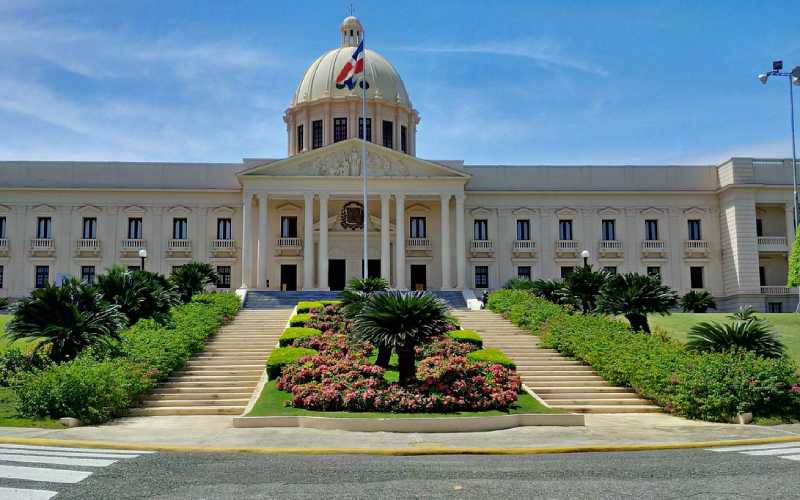
Santo Domingo is one of the oldest continually inhabited cities in the Americas, so it’s no surprise that it is steeped in history and culture. Most cruise passengers spend their day in port exploring the vibrant city with its historical center to soak up its charm, atmosphere, and history.
The Colonial Zone in Santo Domingo is a UNESCO World Heritage Site called Ciudad Colonial. It boasts some of the best-preserved colonial architecture in the Caribbean. Here, you can explore the narrow cobblestone streets, visit historical landmarks such as the Cathedral of Santa María la Menor and the Alcázar de Colón, and enjoy local cuisine at charming cafes and restaurants.
Transportation from the Santo Domingo Cruise Port
What are the best options to get from the Santo Domingo Port to the other attractions in the city or further afield? Here are some recommendations from seasoned cruisers.
Taxi

A taxi from the Santo Domingo Cruise Port is the most convenient and efficient way to explore the city. A taxi rank is located outside the port area, making it easy to travel to your destination. The best advice is to book your cab in advance to avoid waiting in line at the cruise terminal.
The good news about taxis in Santo Domingo is that they are cheap. But it would be best to remember that Santo Domingo taxi drivers don’t use meters. You must negotiate the fare with the driver before getting into the vehicle. Some gentle haggling can often secure you a lower fare.
Uber

Uber is available in Santo Domingo and is a convenient way to get to and from the port. This is a great and safe option, as you avoid the risk of being overcharged if you don’t speak Spanish.
Walking

Walking around the Old Town or the Colonial Zone is the most convenient way to explore Santo Domingo during your cruise day. However, most cruise ships dock at the Sans Souci pier, which is too far to walk to the city’s downtown area. Therefore, a taxi is your only option.
Local bus

Although local buses are plentiful, they are too unreliable for cruise ship passengers. The timetables are erratic, and finding information on specific routes is difficult. Therefore, only consider traveling by city buses if you have excellent Spanish and are familiar with the bus system.
Shuttle bus
Santo Domingo is a homeport, meaning some Eastern or Western Caribbean cruises depart from the port city. If you fly to Las Americas International Airport (SDQ), a shuttle bus is your best option to get to the port. You can book the bus through your cruise line or an independent tour operator.
The airport shuttle bus takes around 30 minutes and costs about $45 to Santo Domingo’s City Center.
Best Things to Do in Santo Domingo City While in Port
The historic Zona Colonial takes you back in time with its 16th- and 17th-century buildings, rich heritage, and centuries-old cobblestone streets. The City Center has buildings from colonial times, plenty of museums, and superb restaurants serving authentic Caribbean cuisine. The city’s east side has the beautiful Parque del Este, with various monuments to the Dominican Republic’s past.
Tour La Zona Colonial

If you’re in Santo Domingo for a cruise day, a guided tour of the Zona Colonial is a must-do activity. The zone covers the area from the Don Diego terminal to the Parque Independencia and from the River Ozama to Av. Mella. This UNESCO World Heritage Site has some of the oldest European settlements in the Caribbean.
You can start your Zona Colonial walking tour from Parque Colón and tour the Catedral Primada de América. Next, head toward the river to the Ozama Fortress. After admiring the medieval castle, go north on Calle Las Damas to Alcázar de Colón and Plaza de la Hispanidad. On the way, you can visit the Panteón de la Patria.
The walking tour can take two to three hours. Other landmarks along the way include the Kahkow Experience and the Plaza María de Toledo. Beside the Plaza de la Hispanidad are four museums:
- Amber World Museum (Museo de Ámbar)
- Wax Museum Juan Pablo Duarte (Museo de Cera Juan Pablo Duarte)
- Museo de Las Atarazanas Reales
- Museum of Rum (Museo del Ron Dominicano)
Basilica Cathedral of Santa Maria La Menor (Cathedral of Santo Domingo)
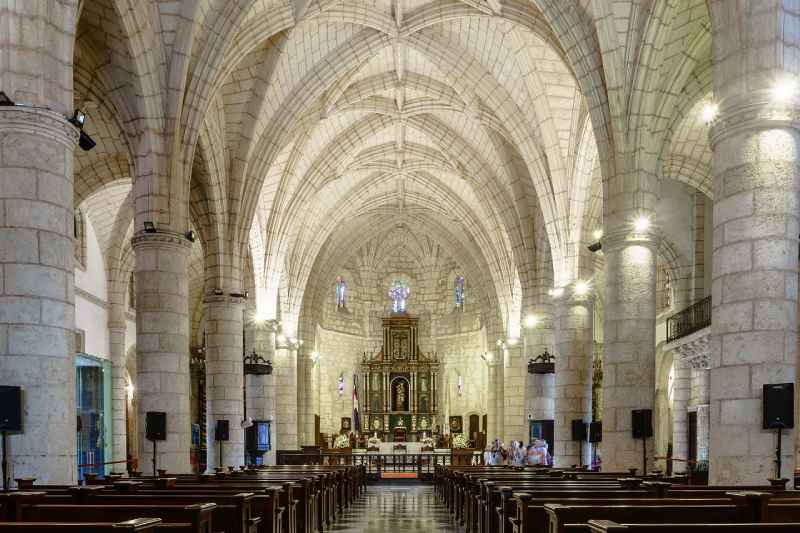
The Basilica Cathedral of Santa Maria La Menor is in the city square in the heart of Santo Domingo. This is the first and oldest cathedral in the Americas. Opened in 1550, this stunning structure combines Gothic and Baroque architectural elements.
The cathedral’s impressive facade features intricate stone carvings and a grand entrance flanked by two towering bells. Inside, you can explore the ornate interior, which includes beautiful, ribbed vaults, 14 side chapels, wooden furniture, and stunning paintings. The cathedral also houses the tombs of several prominent figures in Dominican history.
Until 1795, Christopher Columbus’s remains were in the cathedral’s tomb. Today, the cathedral is one of Old Town’s most popular tourist attractions.
Parque Colón (Columbus Park)
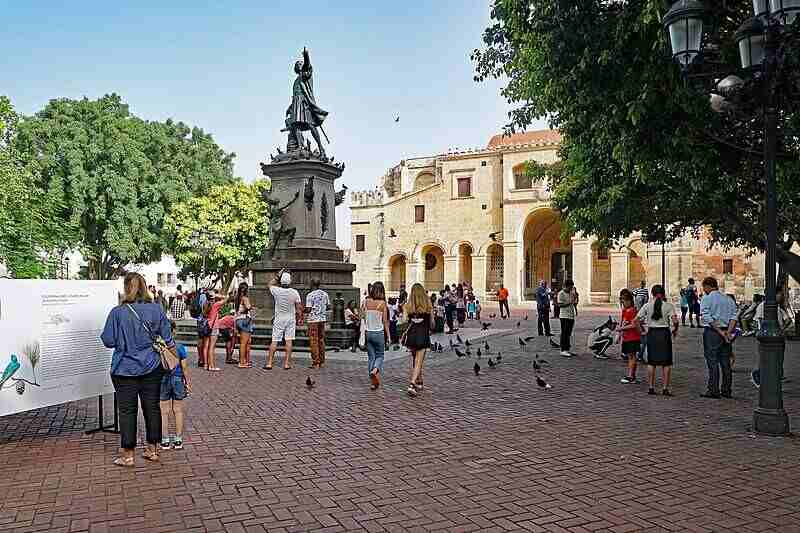
Columbus Park has several not-to-be-missed historical landmarks. For example, it’s home to the Cathedral of Santo Domingo. Other attractions in the square include the following:
- Statue of Christopher Columbus
- Plazoleta de los Curas—a building where priests used to stay
- Monumento al Niño por Nacer, or Monument to the Unborn Child
You can also relax and soak up the square’s vibrant atmosphere at one of the small cafes or bars.
Alcázar de Colón

The Alcázar de Colón is a historical 16th-century building located in the Colonial Zone of Santo Domingo. The majestic building was the residence of Diego Columbus, the son of Christopher Columbus. This impressive structure features a mix of Gothic, Moorish, and Renaissance architectural styles. It’s the first fortified palace in the New World.
You can buy tickets and tour the palace’s interior. In 22 rooms, you can see period furniture, artwork, and original decor. The reception hall, dining room, and bedrooms feature decorative elements from the 14th to 16th centuries. The building also houses a museum that showcases many artifacts from the colonial era.
Alcázar de Colón is a popular tourist attraction due to the spectacular views from the top. To the east, you can see over the River Ozama to the Columbus Lighthouse. On the other side, you get beautiful views of the Plaza de Espana. Most tourists rate the palace as one of the best examples of the colonial era.
Stroll the Calle de Las Damas
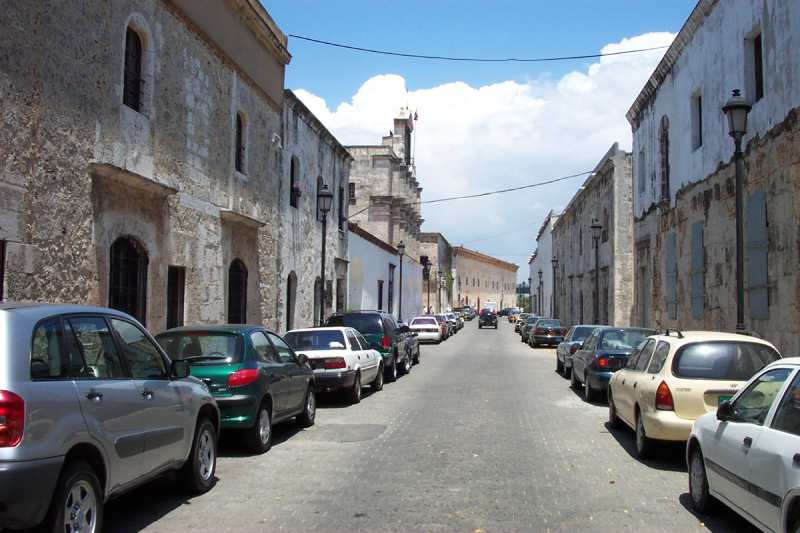
Calle de Las Damas is one of the oldest streets in Santo Domingo and the Americas and one of the New World’s first paved streets. The historic street connects the Alcázar de Colón to the attractive Plaza Pellarano Castro. Strolling down the street, you can view former colonial buildings with their attractive 16th-century architecture.
Originally named Calle Real, it was later renamed Calle de Las Damas (Street of the Ladies) as the wives and daughters of Spanish dignitaries frequented it. Today, the street is lined with shops, cafes, and galleries, making it a popular spot for tourists to explore.
Panteón de la Patria (Pantheon of the Fatherland)
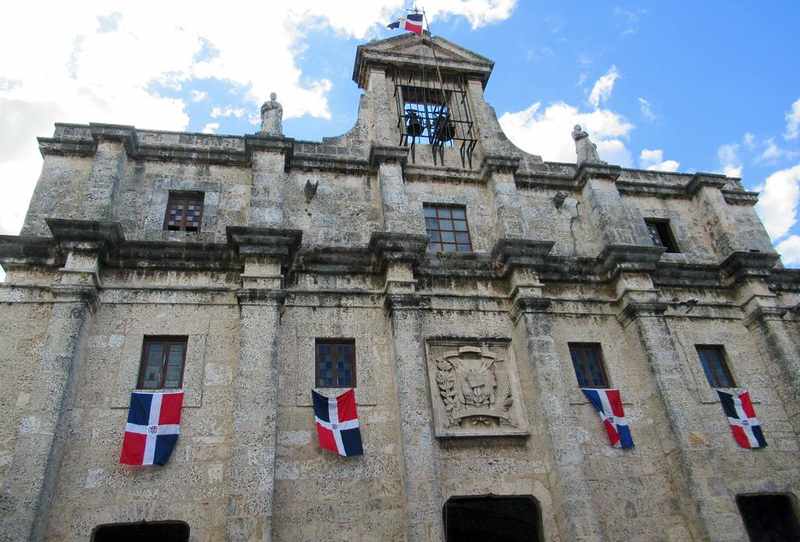
Located on the Calle de Las Damas, the National Pantheon is a mausoleum where prominent figures of the Dominican past are preserved. The building has a neoclassical facade and dates to 1746, when it was built as a Jesuit church. While touring the building, you can marvel at the high, vaulted ceilings and baroque interior.
You can explore the grand hallways and chambers of the Pantheon, which are adorned with marble floors, columns, and statues. The building’s impressive dome, with a mural depicting the Last Judgment and an eternal flame beneath it, is one of its highlights.
Fortaleza Ozama

The Ozama Fortress is one of the oldest military European structures in the Americas. It is part of the UNESCO Ciudad Colonial Zone and features a 60-foot (18 m) tall tower overlooking the Ozama River. The fortress also forms part of the city walls. The building still has its original architecture, tunnels, and dungeons that were once jails.
You can explore the fortress and its various chambers, including a chapel, dungeons, and military quarters. The views from the top of the fortress are breathtaking, offering panoramic views of the city, Ozama River, and the Caribbean Sea.
Fun fact: One of the jail’s previous inmates was Christopher Columbus, who was temporarily imprisoned there in 1500 due to accusations of mismanagement.
Visit a museum in Santo Domingo
Santo Domingo is home to several museums, ideal for history buffs on a cruise. The best museums are located in the UNESCO Ciudad Colonial. Others are near the Plaza de la Cultura, west of the colonial zone.
Here are seven museums in Santo Domingo that offer a glimpse into the city’s rich history and cultural heritage.
Museo de las Casas Reales (Museum of the Royal Houses)
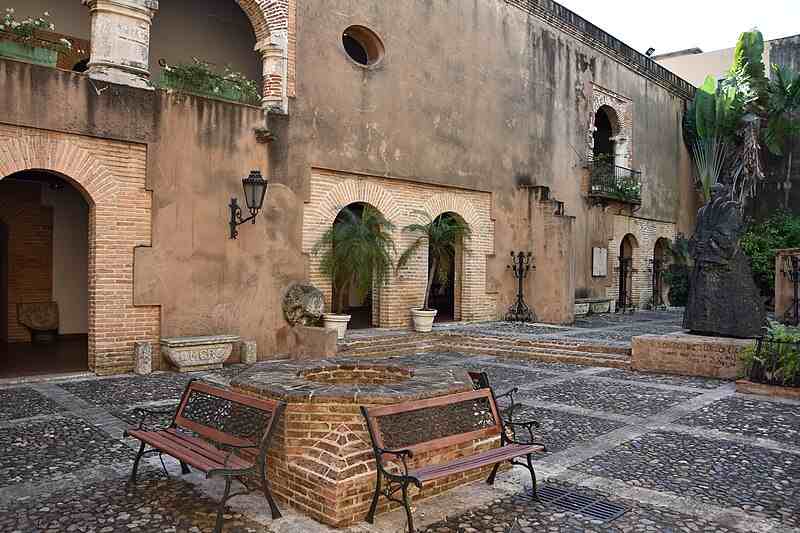
Located in the heart of Santo Domingo’s Colonial Zone, the Museum of the Royal Houses is a popular tourist destination for walking tours. The 16th-century building once housed the administrative headquarters for Spain’s colonies in the Americas. Now, it showcases artifacts from Dominican colonial times.
Located at the top of Calle de Las Damas, the museum has Taino artifacts, weapons, horse-drawn buggies, uniforms, treasure from sunken galleons, model ships, and an armory.
Museo de la Resistencia (Memorial Museum of Dominican Resistance)
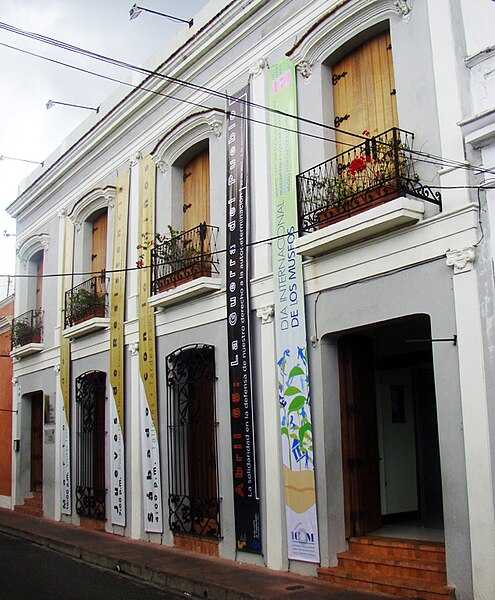
The Memorial Museum of Dominican Resistance is located in the center of Ciudad Colonial. The museum is a powerful reminder of the country’s tumultuous past and the Dominican Republic’s struggle during the Trujillo dictatorship. An eclectic collection of documents, photographs, and personal testimonies highlight the struggles to gain freedom, especially the Mirabal sisters.
The Museum of Resistance is one of the more popular destinations in the Colonial Zone.
Museo de Ámbar (Amber World Museum)

Not far from Alcázar de Colón is the famous Amber World Museum. Set in a stunning 17th-century colonial building, the museum showcases the beauty and history of amber. Here, you can learn about the unique features of Dominican amber and its historical and cultural significance in Dominican culture.
Visiting the museum lets you see stunning fossilized animals set in amber. You can also view rare red, green, and blue amber stones of varying sizes. As a memento of your stay on the island, you can buy souvenirs from the gift shop.
Museo de Arte Moderno (Museum of Modern Art)
If art is your thing, visiting the Museum of Modern Art in Santo Domingo is a must. The art museum showcases modern and contemporary art from the Dominican Republic. Additionally, the museum has a wide range of artwork, including paintings, sculptures, photographs, ceramics, and sculptures.
Located in the Plaza de la Cultura, the modern art museum is near the Museum of Natural History, the National Museum of History and Geography, and the Museum of Dominican Man.
Museo del Hombre Dominicano (Museum of the Dominican Man)

The Museum of the Dominican Man gives you a glimpse into the rich history and cultural heritage of the Dominican Republic. The museum has the most extensive collection of relics and objects from the original Caribbean inhabitants, the Taíno people. The museum also has displays about European colonizers and African slaves.
The Museum of Dominican Man helps visitors understand the local culture and Dominican roots. You’ll find the museum in the Plaza de la Cultura, beside three other popular museums.
Museo de Historia y Geografia (The Museum of History and Geography)
The Museum of History and Geography is a popular attraction in the Plaza de la Cultura, Santo Domingo. The museum gives you a fascinating insight into the island’s rich history and diverse geography. You can learn about marine life, ecology, space, and the ancient inhabitants of the Caribbean.
Exhibits and attractions in the museum include the following:
- Minerals and fossils
- Stuffed animals
- Artifacts from pre-Columbian times
- Displays about the Dominican animals and insects
- Planetarium
Museo Nacional de Historia Natural (National Museum of Natural History)

Located in Plaza de La Cultura, Santo Domingo, the National Museum of Natural History is an excellent place to explore the Dominican Republic’s rich biodiversity. The museum showcases a wide variety of exhibits, including displays on geology, paleontology, botany, zoology, and conservation.
The museum houses fossils, minerals, plants, and animals native to the island. There is also the skeleton of an entire whale. All the exhibits are in Spanish, but the displays are apparent enough for non-Spanish speakers. You may even find a helpful guide who speaks English.
Kahkow Experience
One of the tastiest experiences of touring the Santo Domingo Colonial Zone is visiting a chocolate factory. Located on the Callas de Las Damas, this popular tourist attraction lets you learn about the rich history of cacao in the Dominican Republic. You learn about turning cacao pods into chocolate and then create your own chocolate bar.
But it’s not all just about sweet treats at the Santo Domingo chocolate factory. You also get educated on the role of cacao beans in the cosmetic industry. You can make your own soap products using the finest cacao butter in the world.
Walk along the Malecón
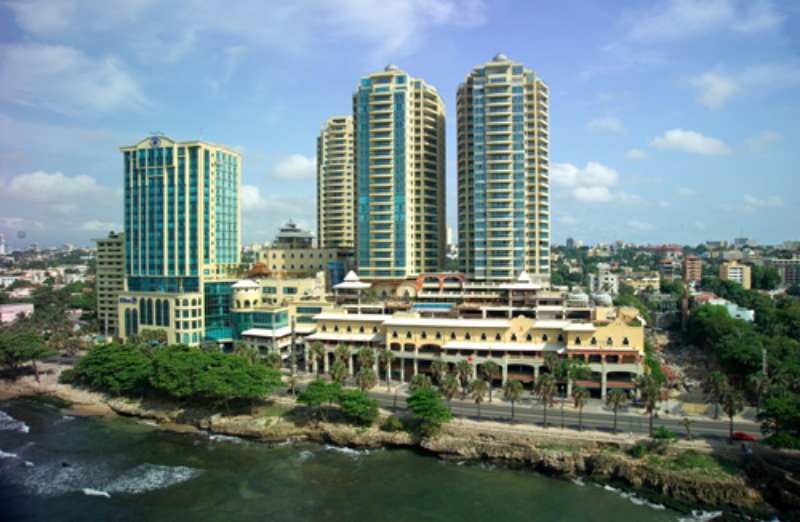
A leisurely walk along the Malecón in Santo Domingo lets you appreciate the power of the Caribbean Sea. The Malecón is a palm-lined promenade along the coast where you can enjoy stunning views of the ocean. A few restaurants and vibrant bars are dotted along the promenade.
It’s good to note that the Malecón runs parallel to a busy road, so you may miss the peace and tranquility of a secluded beach or stroll in a park.
Spend time at the Botanical Gardens
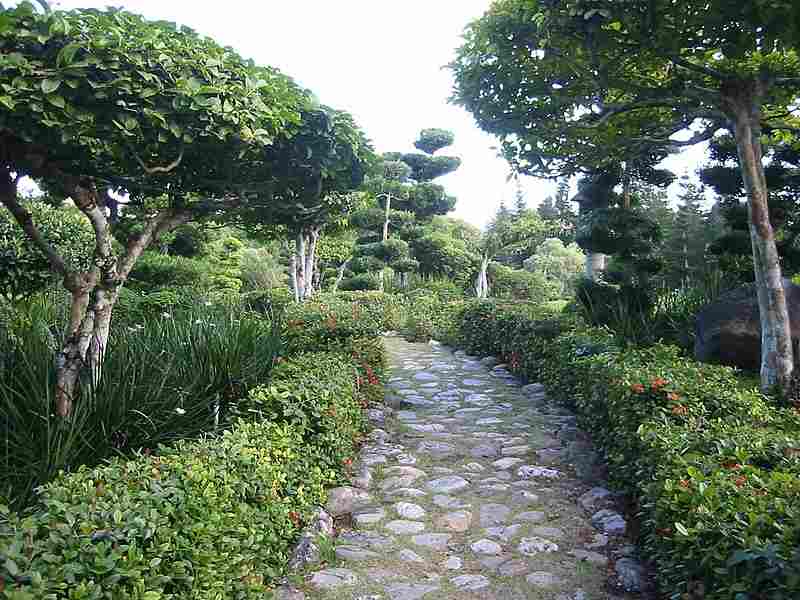
On a cruise day, one of the quietest and most secluded places in Santo Domingo is the city’s Botanical Gardens. The highlight of the attraction is the stunning Japanese Gardens. You can stroll through attractive bamboo gardens, palms, Asiatic shrubs, ponds, and fountains here. There is also a spectacular butterfly garden.
Most tourists describe the gardens as a beautiful place to spend a relaxing day in Santo Domingo. The lush oasis is a 30-minute taxi ride from the cruise port. Depending on your time, you can also plan to visit the zoo (Parque Zoológico Nacional) and Ágora Mall in the same area.
Shopping at the Mercado Modelo
Mercado Modelo is the largest market in Santo Domingo and a popular tourist destination for cruise passengers. It’s located a 10-minute drive from the cruise port. The vibrant market offers a wide variety of indoor and outdoor stalls selling handcrafted souvenirs, local artwork, jewelry, clothing, and traditional Dominican products.
The Mercado Modelo is the best place in Santo Domingo for souvenir shopping. You can find amber necklaces, Dominican cigars, local chocolate, and brightly painted carnival masks. The prices tend to be marked up, so haggling for the best prices is OK.
The market is located on Av. Mella, on the edge of the Colonial Zone of Santo Domingo.
Parque Independencia (Independence Park)
Independence Park is a famous historical and cultural landmark that can be included in a walking tour of the Colonial Zone in Santo Domingo. The park has two national icons—the El Conde Gate and the Altar of the Nation. These monuments celebrate the founders of the Dominican Republic: Juan Pablo Duarte, Ramón Matías Mella, and Francisco del Rosario Sánchez.
The park is beautifully landscaped with lush greenery, statues, and well-maintained pathways. You can view statutes of the Dominican Republic’s past, especially its independence battles with Haiti. The park is a tranquil, serene location ideal for escaping cruise crowds and the commotion of downtown Santo Domingo.
Attractions outside of Santo Domingo’s Cultural Zone
Many historical and cultural attractions are close to the Sans Souci Cruise Terminal on the east side of the River Ozama. Parque del Este, the Columbus Lighthouse, and Three Eyes National Park are also close to the port and just a 5- to 10-minute taxi ride away.
Relax in the Parque del Este
The tranquil Parque del Este is a great place to avoid cruise crowds. This beautiful park is located a short taxi ride from the Santo Domingo Cruise Port. It is the largest green area in the city, with woodlands, tennis courts, a football stadium, a shooting range, and the famous Faro a Colon.
Faro a Colón (Columbus Lighthouse)
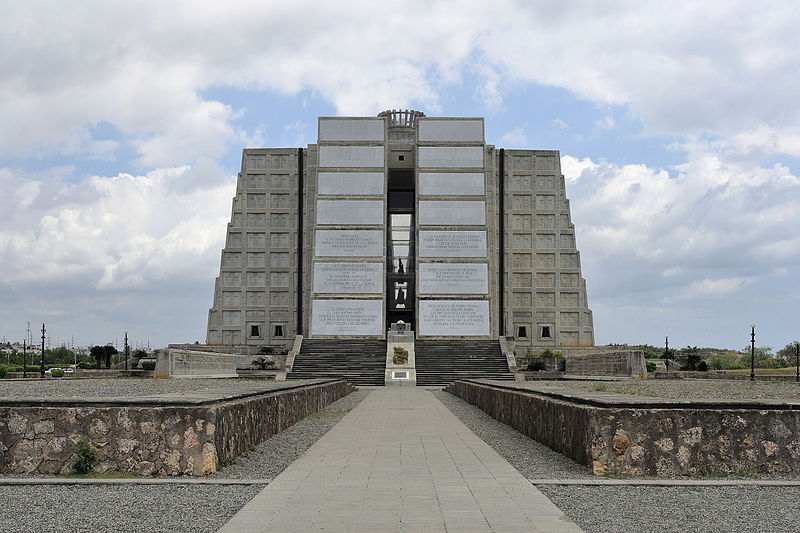
Located east of the River Ozama, the Faro a Colón is a monumental cross-shaped lighthouse and mausoleum commemorating Christopher Columbus. This impressive structure stands over 680 ft. (207 m) long and is illuminated by 157 searchlights, creating a cross shape, and making it a prominent landmark in the city.
The Columbus Lighthouse also houses exhibitions from each country in the Americas. There is also a tomb of Christopher Columbus, which is said to have the remains of the famous explorer. It was opened in 1992 to commemorate the 500th anniversary of Columbus’s first voyage.
Los Tres Ojos (Three Eyes National Park)
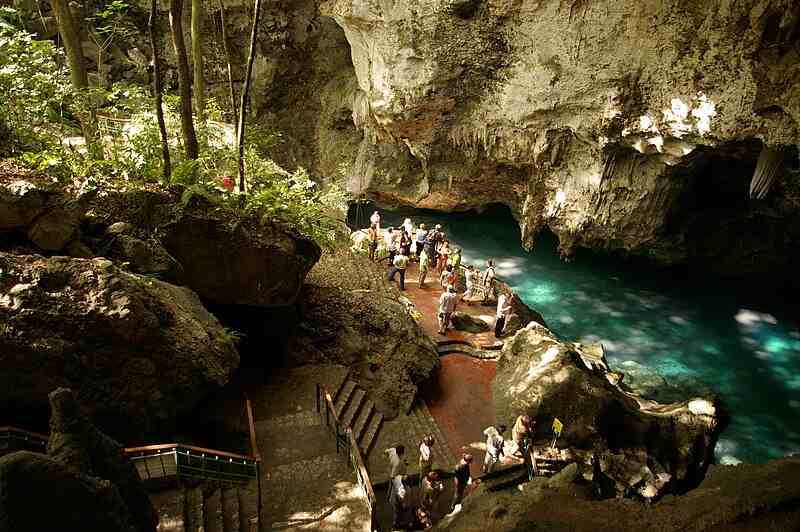
The Three Eyes National Park is a 10-minute drive from the cruise terminal in Santo Domingo at the east end of Parque del Este. This attraction is a stunning open-air cave with a series of underground cave systems. The caves feature four crystal-clear turquoise lakes surrounded by lush tropical vegetation.
You can explore the Los Tres Ojos caves via a network of pathways and wooden walkways that wind through the park. The caves are illuminated with soft lighting, creating a magical atmosphere. Boat rides can take you around the underground lakes and provide a unique perspective of this natural wonder.
The Taíno Indians originally used the caves for fertility rites and religious rituals. They called the blue lagoons “eyes” due to their oval shape. You can also access a fourth cave via a small wooden barge.
Los Tres Ojos is one of the most-visited tourist destinations in Santo Domingo. While exploring the caves and strolling through the park, imagining yourself in the Dominican Republic’s biggest city is hard to imagine.
Eating out in Santo Domingo
Santo Domingo offers a wide range of dining options, from casual street food vendors to high-end gourmet restaurants. The rich culinary landscape mirrors the city’s cultural diversity and history. Dominican cuisine is a fusion of Caribbean flavors, Spanish influences, and African heritage.
Dominican cuisine: main meals and side dishes
Here are some must-try dishes to try during your day in port in Santo Domingo:
- La Bandera Dominicana: This traditional lunch is a hearty meal of rice, beans, and meat in a rich tomato sauce.
- Sancocho: One of the most popular Dominican dishes, Sancocho is a stew made from vegetables, meats, and tubers. It can include chicken, beef, sweet potatoes, pumpkin, and cassava roots.
- Mangú: This Dominican dish is a creamy plantain mash that can be served with meat, cheese, and eggs.
- Tostones: Also called patacones, this delicious dish consists of twice-fried plantain slices that are crispy on the outside and soft in the middle. It is usually served as an appetizer or a side dish.
- Mofongo: Dominicans have adopted this Puerto Rican side dish. It’s made from fried green plantains, crispy pork skin, and fresh garlic. The dish is served with chicken broth or red shrimp sauce.
Dominican Republic street food and snacks
If you are short on time or prefer to eat on the go, Santo Domingo’s street food is a great way to sample local flavors. Here are some tasty treats to try when in port:
- Chimichurri burgers: This popular Dominican street food is made from spiced pork or beef and served with cabbage slaw, tomato, and onion on a toasted bun.
- Empanadas: Found throughout the Caribbean, these delicious fried pastries are filled with cheese, meats, or seafood. You can easily find street vendors selling them throughout the city.
- Yaniqueque: This is a popular snack in the Dominican Republic. It is a type of fried dough similar to a flatbread or fritter, often enjoyed with various toppings such as cheese, salami, or avocado.
Desserts and sweets
Dominican sweets are rich and often coconut-based, making them perfect for concluding a traditional meal. Here are a few to try:
- Dulce de Leche: This tasty sweet treat is made from curdled milk, sweetened, and then flavored with cinnamon. Many recipes exist, and the sweet’s consistency can be anything from creamy like custard to solid like milk fudge.
- Arroz con Leche: This dessert is a type of rice pudding made with evaporated milk, sugar, cinnamon, and raisins.
- Tres Leches Cake: A quintessential Dominican dessert, Tres Leches Cake is a sponge cake soaked in three types of milk: evaporated milk, condensed milk, and heavy cream. It’s topped with white sugar frosting and cherries.
Practical tips for dining out in Santo Domingo
Here are a few practical tips to keep in mind to ensure you have an enjoyable experience when dining out in Santo Domingo:
- Water Safety: Drinking bottled water rather than tap water is advisable. Also, make sure that the ice is not made from tap water.
- Tipping: While tipping is customary—often around 10%—check your bill, as service charges are sometimes included.
- Hygiene: While street food can be delicious, to avoid foodborne illnesses, choose vendors that look clean and well-maintained.
By following these tips and trying some of the delicious dishes mentioned above, you will surely have a memorable culinary experience in Santo Domingo.
Best Activities Near Santo Domingo on a Cruise Day
Several shore excursions from your cruise line or an independent tour operator are available if you want to escape the city and explore the lush Dominican countryside.
Play a round of golf

Several excellent golf courses are available by taking a short taxi ride from the Santo Domingo Cruise Port. You can enjoy a round of golf at some of the top courses in the Dominican Republic. Here are a few golf clubs under a 45-minute drive from the terminal:
- Santo Domingo Country Club: This country club has two courses, one with 18 holes and the other with nine holes. The course is a 20-minute drive west of Santo Domingo.
- Isabel Villas Golf and Country Club: Located a 30-minute drive from the cruise terminal, the nine-hole course is popular with cruise passengers.
- Cayacoa Golf Club: The 18-hole golf course features narrow fairways, hilly terrain, scenic views, and small lakes. Getting to the golf club takes around 45 minutes by taxi from the port.
Ron Barceló rum excursion
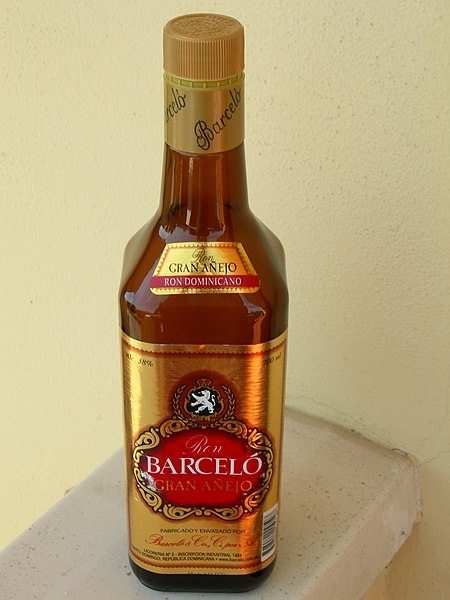
Learn about the history of rum production in the Dominican Republic by visiting the world-famous Ron Barceló rum distillery. This popular shore excursion tells about harvesting, distilling, and aging sugar cane to produce rum. Tours also include samples of various Dominican rums and an in-depth guide.
After the distillery tour, you can purchase bottles of rum to take home as souvenirs. Some excursions may also include visiting a local market or beach, relaxing, and enjoying the beautiful Caribbean scenery.
The rum distillery is best enjoyed on a shore excursion that includes other attractions in the area. It’s a 60-minute bus ride from the Sans Souci cruise terminal.
Salto de Socoa Waterfalls
A shore excursion on your cruise day to Socoa Falls is an unforgettable experience. You get to walk through the lush jungle, swim in natural pools, and admire the crystal-clear water cascading from a height of 65 ft. (20 m). The waterfalls are a designated natural monument for their outstanding beauty.
It’s good to note that the Salto de Socoa Waterfalls are nestled in a lush tropical rainforest about an hour from Santo Domingo. Also, there is a 20-minute hike through the rainforest to get to the waterfalls.
Waterfalls at Monte Plata
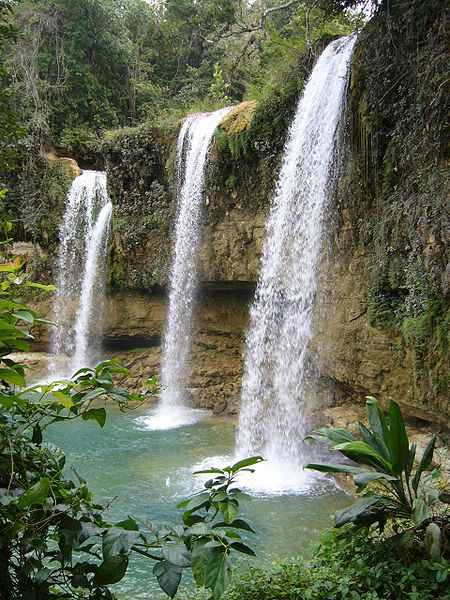
Some of the country’s most spectacular waterfalls are located a 45-minute bus ride from the Santo Domingo cruise pier. The stunning Sierra de Auga Waterfalls at Monte Plata have three sides with water cascading from 50 ft. (15 m) high. Some tours also include lunch in local villages.
The Best Water Excursions in Santo Domingo
Santo Domingo lacks many water excursions that are popular in other Dominican Republic cruise destinations like Amber Cove, Punta Cana, or La Romana. However, cruise ship passengers can enjoy fun water activities that are not far from the city.
Swimming, snorkeling, or scuba diving from Boca Chica
The closest beach to Santo Domingo for watersports is Boca Chica. From here, you can arrange snorkeling or diving to nearby coral reefs and shipwrecks. The calm, shallow waters of the cove make it one of the best places near Santo Domingo for swimming. Several diving operators offer boat tours from the marina.
La Caleta Underwater National Park
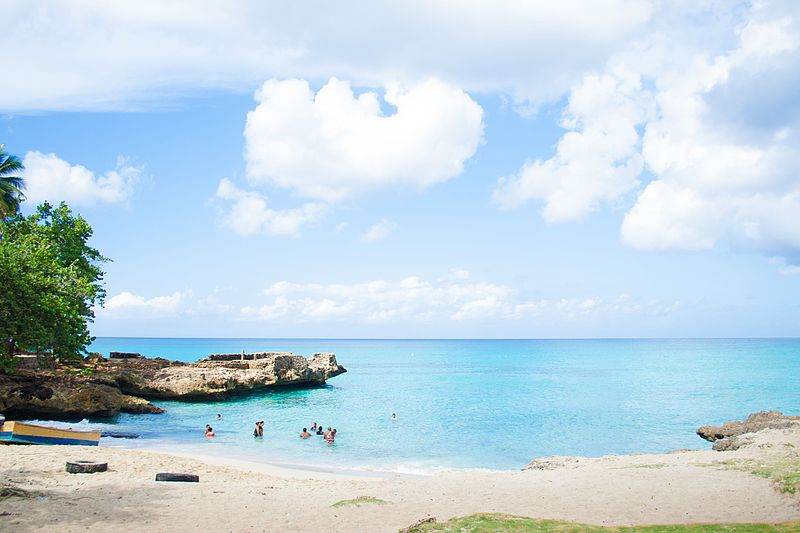
If you are an experienced diver, don’t miss the opportunity to explore La Caleta Underwater National Park. This marine protected area is home to several shipwrecks, colorful coral reefs, tropical fish, and other marine life. Guided snorkeling and scuba diving tours are available for cruise passengers looking to discover the underwater beauty of the Dominican Republic.
The Best Beaches in Santo Domingo
Santo Domingo lacks the pristine beaches that other cruise destinations in the Caribbean are famous for.
So, if you are looking for a beach break, you must travel between 30 and 40 minutes to find a lovely sandy beach. The closest beach to the city is Playa de Guibia. It’s a public beach, but not well-maintained, quite dirty, and not great for swimming.
Here is information on the most beautiful beaches near Santo Domingo.
Boca Chica Beach
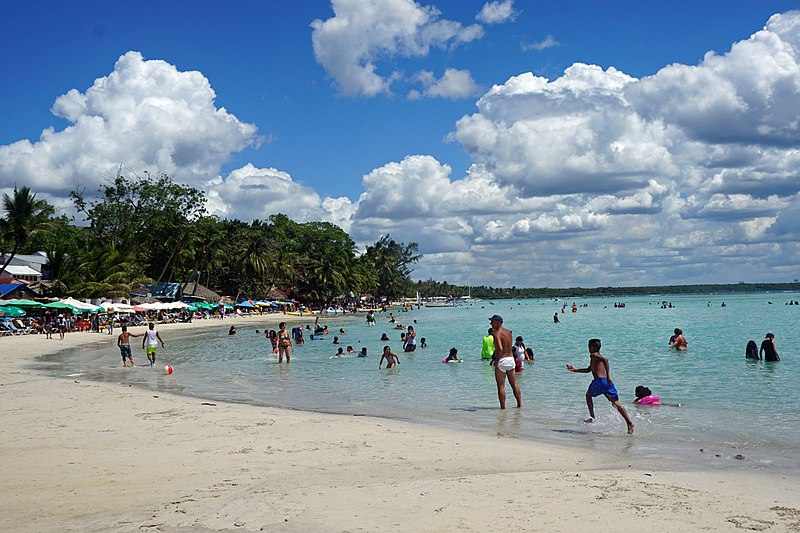
Boca Chica is one of the best beach towns near Santo Domingo, Dominican Republic. The stunning beach is lined with palm trees, has fine white-sand, and has crystal clear waters. The oceanfront village also has two marinas and plenty of restaurants and bars.
Boca Chica Beach is one of the safest beaches on the Dominican Republic’s southern coast. The calm waters are shallow and only reach up to waist level. Also, plenty of local businesses hire snorkeling gear, paddleboards, and kayaks
Boca Chica is approximately 23 miles (about 37 kilometers) east of Santo Domingo. It typically takes about 30-40 minutes by car, depending on traffic conditions.
Playa Guayacanes
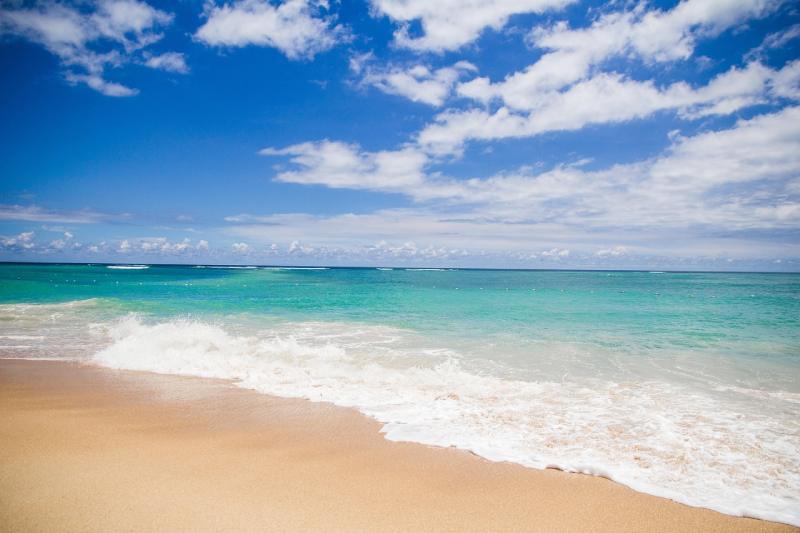
Playa Guayacanes is a pristine beach located 40 minutes from Santo Domingo. The white sand beach has crystal-clear turquoise waters, a few restaurants on the beachfront, and coconut palms. The beach at Guayacanes village is ideal for a quiet beach break as it is rarely crowded with tourists.
Juan Dolio Beach
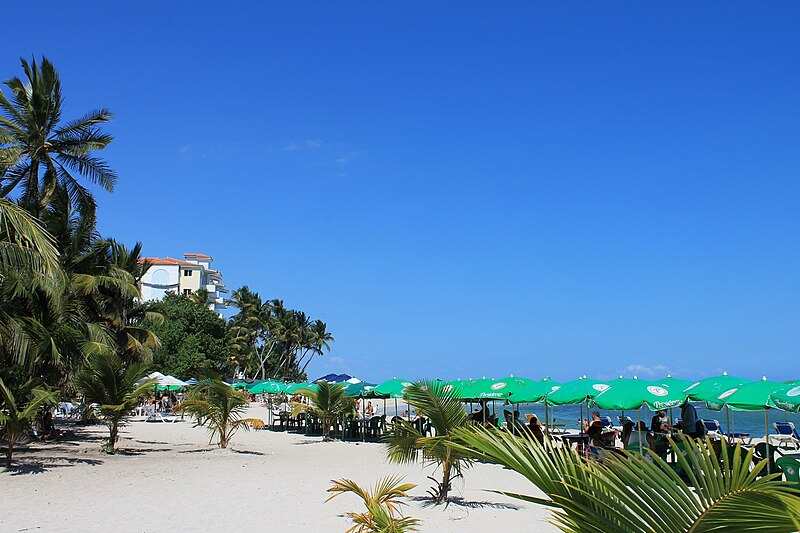
Juan Dolio Beach is a beautiful 6-mile stretch of white sands lined with palm trees. Although it’s a public beach, several resorts restrict access to parts of it. The beach is also known for its large waves, so it’s not ideal for beach breaks if you have young children.
Juan Dolio Beach is approximately 40 miles (about 64 kilometers) east of Santo Domingo. Travel time by car can range from 45 minutes to 1 hour, depending on traffic conditions.
Santo Domingo Cruise Port: FAQs
When is the best time to visit Santo Domingo on a cruise?
The best time to book a Caribbean cruise to Santo Domingo is during the dry season, from mid-November through April. During this time, the weather is cooler, and exploring the city’s attractions is more comfortable. Additionally, there are fewer chances of tropical storms or hurricanes, which can disrupt Caribbean itineraries.
Cheaper Caribbean cruises are available from June through November, but you risk disrupting your itinerary due to wetter, unsettled weather. It’s also the time when the risk of hurricanes increases. The worst month to book a cruise in the Caribbean is October.
What is the currency in Santo Domingo, and can I use US dollars?
The Dominican Peso (DOP) is the official currency of the Dominican Republic. Its symbol is $, or RD$. Many vendors, cafes, and restaurants accept US dollars in the major tourist resorts. However, they may give you change in pesos.
Is it safe to walk around Santo Domingo?
Santo Domingo is generally considered a safe city if you stick to the main tourist hotspots. However, like in any city, it is essential to exercise caution and be aware of your surroundings. The best option is to get a taxi directly from the port rather than walking.
Is tap water safe to drink in Santo Domingo?
In Santo Domingo, tap water is not safe to drink. Therefore, you should only drink bottled water or boiled water. Remember to take plenty of water to stay hydrated in the hot, humid climate. Although many restaurants may have filtration systems, it is still best to err on the side of caution, opt for bottled water, and avoid ice.
How much should I tip in Santo Domingo?
Tipping is common in Santo Domingo, and it’s customary to tip restaurant staff, tour guides, drivers, and hotel staff 10% of the price. Check the bill in restaurants, as they may already add a gratuity. In this case, tipping is optional.
Can I communicate in English during my cruise day in Santo Domingo?
While Spanish is the country’s official language, most people working in the tourism industry in Santo Domingo speak English. However, learning a few basic Spanish phrases is a good courtesy.
Related articles:

